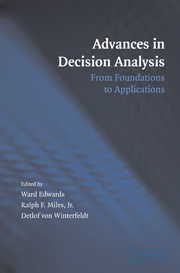Book contents
- Frontmatter
- Contents
- List of Contributors
- Preface
- 1 Introduction
- PART I HISTORY AND FOUNDATIONS OF DECISION ANALYSIS
- PART II STRUCTURING DECISION PROBLEMS
- PART III PROBABILITIES AND BAYES NETS
- PART IV UTILITIES
- PART V RISK ANALYSIS
- PART VI DECISION ANALYSIS IN A BEHAVIORAL AND ORGANIZATIONAL CONTEXT
- 18 What Have We Learned from Our Mistakes?
- 19 Decision Conferencing
- 20 Resource Allocation Decisions
- 21 From Decision Analysis to the Decision Organization
- 22 Building Decision Competency in Organizations
- 23 Negotiation Analysis: Between Decisions and Games
- PART VII APPLICATIONS OF DECISION ANALYSIS
- Index
- References
19 - Decision Conferencing
Published online by Cambridge University Press: 05 June 2012
- Frontmatter
- Contents
- List of Contributors
- Preface
- 1 Introduction
- PART I HISTORY AND FOUNDATIONS OF DECISION ANALYSIS
- PART II STRUCTURING DECISION PROBLEMS
- PART III PROBABILITIES AND BAYES NETS
- PART IV UTILITIES
- PART V RISK ANALYSIS
- PART VI DECISION ANALYSIS IN A BEHAVIORAL AND ORGANIZATIONAL CONTEXT
- 18 What Have We Learned from Our Mistakes?
- 19 Decision Conferencing
- 20 Resource Allocation Decisions
- 21 From Decision Analysis to the Decision Organization
- 22 Building Decision Competency in Organizations
- 23 Negotiation Analysis: Between Decisions and Games
- PART VII APPLICATIONS OF DECISION ANALYSIS
- Index
- References
Summary
ABSTRACT. This chapter presents the current status of the decision conference process, a way of helping a group of key players to resolve important issues in their organization by working together, under the guidance of an impartial facilitator, with the aid of a decision analysis model of participants' perspectives on the issues, developed on-the-spot over a period of two days. The facilitator serves as a process consultant, guiding the group through the stages of discussing the issues, developing a model, and exploring the results, without contributing to the content of discussions. The model serves as a “tool for thinking,” not as providing an optimal solution or “the right answer.” Participants are encouraged to express their sense of unease at any stage in the process, for it is the discrepancy between model results and intuitive judgment that drives the dialectic in the group. Exploration generates new insights and stimulates creative thinking, resulting in changes to the model and to intuitions. As this process settles down, participants develop a shared understanding of the issues, generate a sense of common purpose, and gain commitment to the way forward. Two case studies illustrate a typical individual decision conference and how sustained engagement with a client, decision conferencing, can lead to committed alignment in a group. Research on decision conferences provides insights into why decision conferences work.
Information
- Type
- Chapter
- Information
- Advances in Decision AnalysisFrom Foundations to Applications, pp. 375 - 399Publisher: Cambridge University PressPrint publication year: 2007
References
Accessibility standard: Unknown
Why this information is here
This section outlines the accessibility features of this content - including support for screen readers, full keyboard navigation and high-contrast display options. This may not be relevant for you.Accessibility Information
- 111
- Cited by
